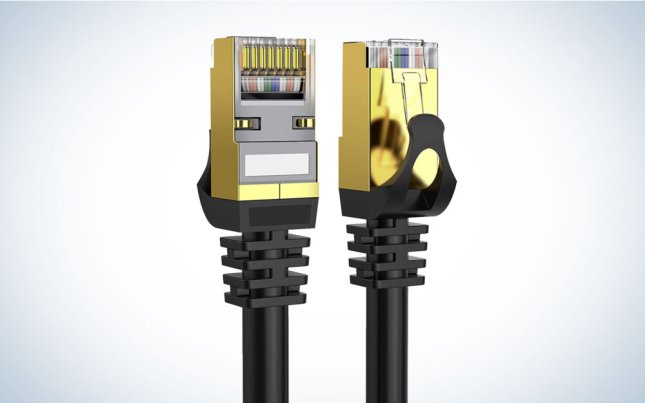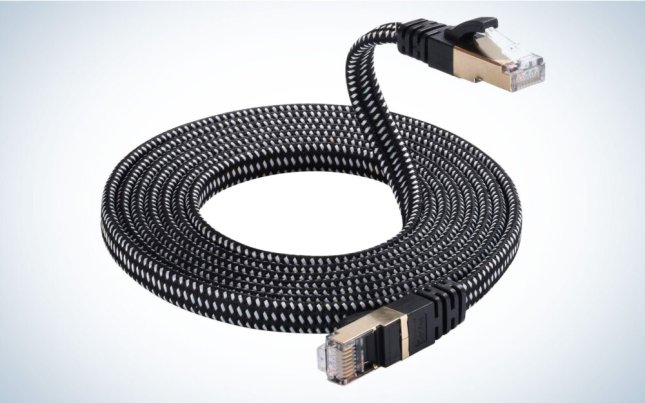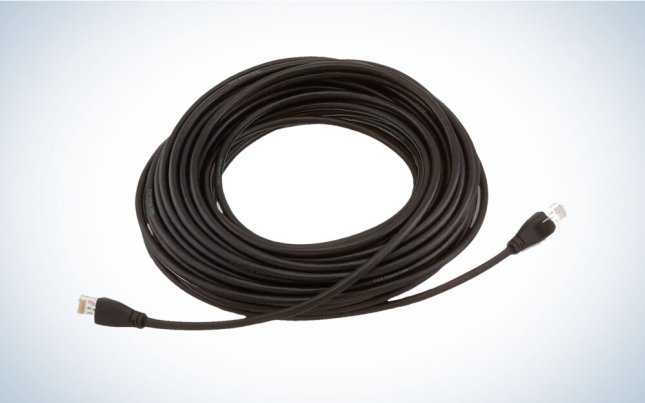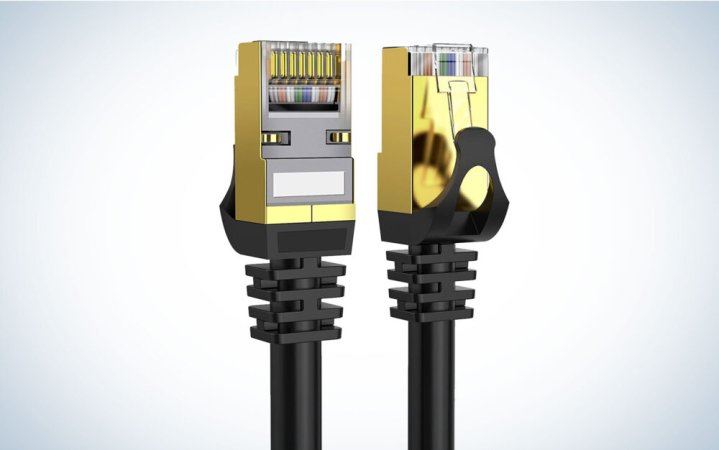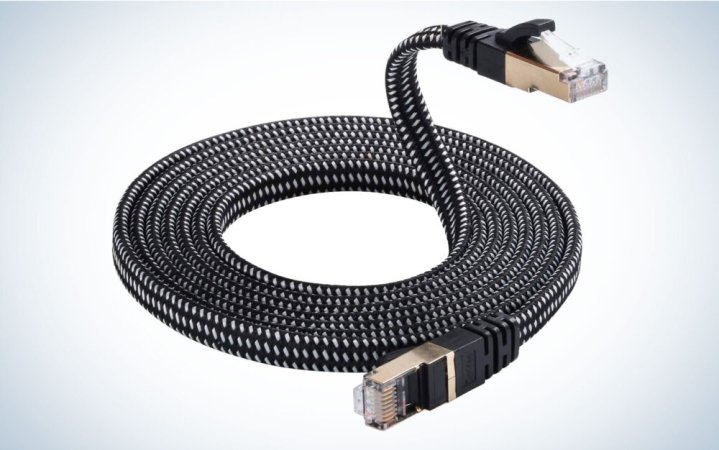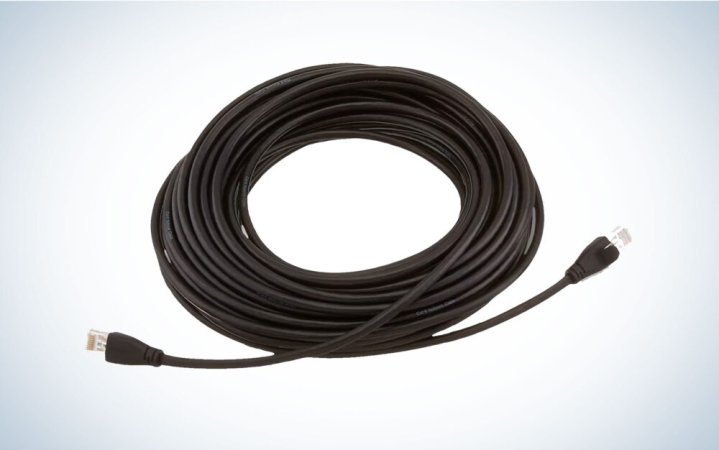We may earn revenue from the products available on this page and participate in affiliate programs. Learn more ›
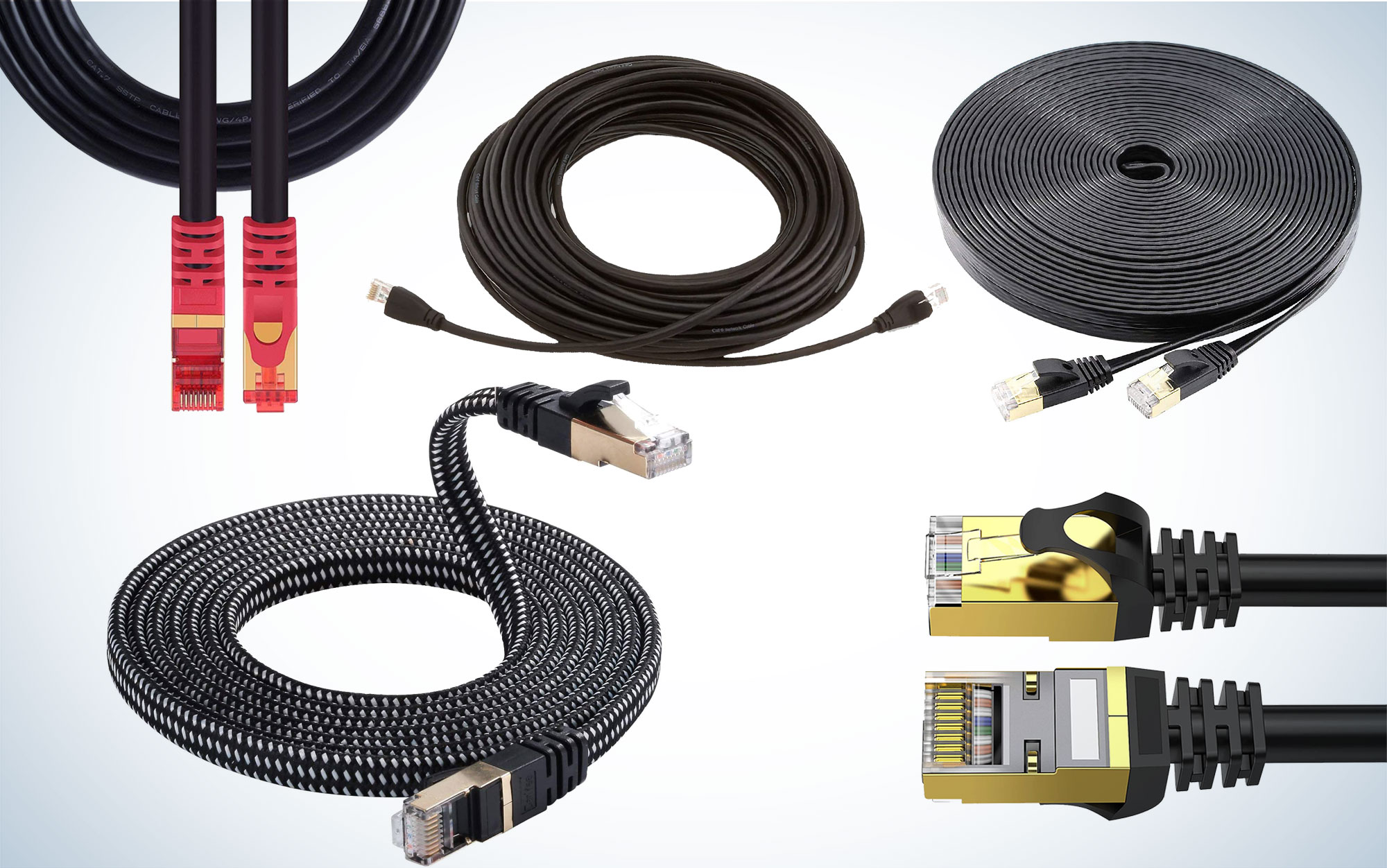
Ethernet cables may not be the flashiest part of your rig, but they are an absolutely essential piece of gaming hardware. Wi-Fi is getting better all the time, and many people have effectively gone completely wireless, but even then you still need an Ethernet cable to connect the modem and router. Moreover, gamers know that having a wired connection to your PC or console is still unbeatable, whether you’re playing competitive matches, trying to maintain a steady Twitch stream, or just hoping to download the latest Modern Warfare update in time for you to actually play it before going to bed.
Though they aren’t complicated, Ethernet cables can be confusing. With new and improved standards coming out every few years, it isn’t always clear what’s changing and when you might need to upgrade your cables. We’re here to demystify terms like “Cat6” and “Unshielded Twisted Pairs” so you can find the best Ethernet cable for gaming to suit your particular needs.
- Best Cat8: Dacrown Cat8
- Best braided: Danyee Cat7 Braided
- Best flat: Jadaol Cat7
- Best outdoor: Shinekee Outdoor Cat7
- Best Cat6: Amazon Basics Cat6
How we picked the best Ethernet cables for gaming
Ethernet cables are fairly straightforward as far as consumer tech goes, so there aren’t a ton of different specs, variants, or subcategories to consider—cables do one thing. We’re looking for the ones that do it well. We combed through round-ups and reviews to see what other professionals recommended, but this isn’t a hardware category that lends itself particularly well to traditional criticism. Instead, we relied much more on collating consumer reviews to find the products that are most consistent and long-lasting.
All of this was, of course, filtered through extensive research into the history and current state of Ethernet technology, as well as decades of personal experience in home networking and online gaming—this very copy was submitted over our best flat cable.
The best Ethernet cables for gaming: Reviews & Recommendations
Unless you’re really trying to scrimp and save, almost any Ethernet cable you’ll buy for gaming is going to be capable of handling way more bandwidth than your ISP provides. After deciding how much extra capacity you’d like to pad in, picking comes down to your particular needs—flat cables are easier to run under carpets or through door frames; extra weatherproofing lets you run cable outside and underground; braiding and colors can meet your aesthetic needs. Sometimes it even comes down to what lengths of cable the manufacturers sell. Each of these brands and specific recommendations was selected because they offer high performance and strong approval from their users.
Best Cat8: Dacrown Cat8
Best Cat8 ethernet cable for gaming
Make Way For The Information Superhighway
Pros
- Extremely fast throughput
- Durable PVC weather-proofing
Wide range of available lengths
Cons
- Expensive
Why it made the cut: Dacrown makes the best-reviewed consumer-grade Cat8 Ethernet cable that we could find.
Specs:
- Standard: Cat8
- Frequency: 2000 MHz
- Speed: 40 Gbps
- Length: 5-150 ft
- Shielding: S/FTP
If you’re searching for the best Ethernet cable for gaming, then you’re going to naturally be drawn to Cat8 as the highest standard available right now. Many brands make Cat8 cables but we found that Dacrown’s edged out the competition in both consumers’ and critics’ reviews for delivering steady, high-speed internet at a relatively reasonable price. There is some debate among users about whether most consumer-grade Cat8 cable is “true” Cat8, capable of supporting the format’s full potential, but people who use Dacrown cables tend to be happy with their performance. For gaming, Dacrown’s Cat8 Ethernet cable will ensure a fast and solid connection for the foreseeable future.
Best braided: Danyee Cat7 Braided
Best braided ethernet cable for gaming
Style and Substance
Pros
- Excellent data speed
- Multiple options for stylish nylon braiding
- Flat
Cons
- Stiff
- Nylon could fray
Why it made the cut: Among the best Cat7 Ethernet cables, Danyee’s braided design stands out as the most stylish.
Specs:
- Standard: Cat7
- Frequency: 600 MHz
- Speed: 10 Gbps
- Length: 1.6-100 ft
- Shielding: STP
Virtually all Ethernet cables are coated in plain, monochromatic plastic. That’s fine if you’re able to discreetly run them out of sight, but otherwise magnifies the eyesore caused by poorly managed cabling. While several brands offer colored plastic, Danyee goes above and beyond with its series of premium nylon-braided Cat7 cables in four different patterns and colors. The cable is flat, which is helpful if you need to run it under carpet or through a door, and the nylon weave coating adds friction to reduce sliding around making this cable the best braided Ethernet cable for gaming. There’s one small downside: Since the cable features both nylon and PVC coating, the cable is stiffer and harder to manipulate. There are also rare reports of the nylon fraying with excessive handling.
Best flat: Jadaol Cat7
Best flat ethernet cable for gaming: Jadaol Cat7
Cable? What Cable?
Pros
- Excellent data speed
- Flat
- Included clips
Cons
- Lack of length options
Why it made the cut: Jadaol’s sturdy, flat, and flexible cables are perfect for long and unobtrusive runs.
Specs:
- Standard: Cat7
- Frequency: 600 MHz
- Speed: 10 Gbps
- Length: 25-100ft
- Shielding: STP
Standard Ethernet cables are round, but flat cables can be essential if you need to run them through tight spaces like under carpets or through walls. Jadaol makes the best flat Ethernet cable for gaming at various standards that are both durable and highly flexible, making it as easy as possible to run them around corners and through tight spaces without putting any strain on the wires within. The included nail-in clips aid this even further, making it quick and easy to neatly tuck the cable against the baseboard, around a door frame, etc. With only 25-, 50-, and 100-foot options available, it may be hard to get the exact length you need, especially for short runs. If you’re looking for a discrete, high-speed option to slip under rugs and behind furniture, though, these are the cables you need.
Best outdoor: Shinekee Outdoor Cat7
Best outdoor ethernet cable for gaming: Shinekee Outdoor Cat7
A Cable for All Seasons
Pros
- Excellent data speed
- Heavy-duty PVC coating
- Rated for outdoor and underground use
Cons
- Expensive
Why it made the cut: Shinekee’s heavy-duty outdoor cable delivers the full potential of Cat7 Ethernet in a form factor that’s tough enough to brave the elements.
Specs:
- Standard: Cat7
- Frequency: 600 MHz
- Speed: 10 Gbps
- Length: 25-200ft
- Shielding: STP
When you need to run your Ethernet outdoors, it’s absolutely worth spending a little more to get an outdoor cable that’s made to endure the elements. Shinekee’s outdoor cable has the same high-quality internals as the other cables on our list (shielded, twisted pairs of copper cable and gold connectors), but with an extra durable PVC coating that’s water- and UV-proof, and is rated for being buried underground. With a 200-foot option, it’s also the longest cable in our list by a wide margin and should maintain its full Cat7 speed at that length.
Best Cat6: Amazon Basics Cat6
Best Cat6 ethernet cable for gaming
No Nonsense
Pros
- Dependable gigabit performance
- Good variety of size options
- Great value
Cons
- Only Cat6
- Maximum 50ft
Why it made the cut: Amazon Basics’ cable is the cheapest, most dependable Cat6 available in a wide variety of lengths.
Specs:
- Standard: Cat6
- Frequency: 250 MHz
- Speed: 1 Gbps
- Length: 3-50ft
- Shielding: UTP
Ethernet cables are right in the sweet spot for Amazon Basics. As a widely used commodity without much brand loyalty, it’s easy for Amazon to leverage its massive scale with inexpensive gear. If you just want dependable gigabit internet and want to pay as little as possible, Amazon Basics’ Cat6 Ethernet cable for gaming is hard to beat. It doesn’t go any longer than 50 feet, so you won’t use it for big projects, but there are more options at the short-run cables than any other brand on our list.
Things to consider before buying the best Ethernet cables for gaming
It’s very easy to get frustrated trying to look at the differences between Ethernet cables. The standard for telling cables apart is unique and confusing, making labels and product listing hard to understand. Here’s a little primer on how to separate the good Ethernet cables from the bad, whether or not you’re using them for gaming.
Pick your cable to match your internet service
Remember: The Ethernet cable is just a pipe (or a tube) for your internet connection. The maximum internet speed set by your data plan, measured in megabytes (or increasingly gigabytes) per second, sets the upper limit of what your connection is capable of. If your ISP limits you to 50 Mbps, then more advanced cables that can accommodate 10+ Gbps will be overkill. Going the other way, if you pay for a high-speed plan, then you’ll want to ensure you aren’t throttling it by using a sub-par cable.
Plan the work, work the plan
The length of Ethernet cables has a tangible impact on the quality of your service. The greater the length of the cable between a source and a receiver, the more the signal will degrade, effectively slowing down your internet. Ideally, you want to place your modem as close as possible to your router and other devices that you plan to connect via wired internet to minimize the distance of cable you need to connect them.
To make your setup as efficient (and hidden) as possible, you should plan out your setup and figure out how to route your cables before setting up a device with an Ethernet connection. Once you know where things will be, measure the distance that the cable will need to run and then purchase a cable as close to that length as possible (while still of course giving yourself a little slack to work with). Ethernet cables are fairly cheap and the difference in price between the most and least expensive is especially small for short lengths of cable. It’s easy to justify a tiny splurge on a thoroughly future-proofed cable if you aren’t trying to wire up a whole house.
Herding “Cats”
The primary way that Ethernet cables are labeled is by “Cat,” short for category. The numbered categories—Cat1 through the most recent Cat8—refer to different generations of standards created by the Institute of Electric and Electronic Engineers (IEEE), a technology consortium that sets independent standards for many aspects of tech. IEEE standards ensure that each category is a notable jump in data transfer speed and efficiency while maintaining certain qualitative standards, including backward compatibility with older cables.
Since this list is for the best Ethernet cables for gaming, which requires fast and consistent internet, we recommend that you look for Cat7 or Cat8 cable, with Cat6 as a budget-conscious backup. All three tiers accommodate gigabit-plus internet, giving you full access to a high-speed connection. Cat5 is still in fairly common use, but the difference in price is so minuscule that you might as well at least go for six.
Cat6 supports a frequency of 250MHz, which translates to 1 Gbps over up to 100 meters of cable and 10 Gbps over up to 55 meters of cable. If you want to shoot for the moon, Cat7 runs at 600MHz, which translates to 10 Gbps over up to 100 meters of cable. It’s also more durable and features less signal distortion than lower categories. Cat8, the current top standard, jumps up to 2GHz, so it can support wild speeds of 25 or even 40 Gbps up over up to 30 meters of cable, or comfortably support 10 Gbps over 100 meters of cable.
You may be thinking to yourself, “40 Gbps seems like incredible overkill for my 1 Gbps home network,” and you’d be right! Cat8 (like Cat6 when it was first introduced in the early 2000s) is primarily meant for enterprise applications for technology industry applications like data centers.
That said, newer Cats are also held to higher construction standards that minimize noise and increase lifespan. If you’re buying large amounts of Ethernet cable to run through the walls of your home, you may consider spending the money to buy better cable that will last longer. While it’s primarily meant for businesses, Cat8 is available to the average consumer, and often marketed as the cutting edge of home networking.
Shielding, foil, and twisted pairs
All cables Cat6 and up are shielded from internal “crosstalk” (interference generated by other wires within the cable) by way of “twisted pairs,” which aren’t just the performative emo couple from your high school but refers to literally tangled wires that, through the magic of electromagnetics, somehow reduces noise.
Twisted pairs are just the baseline for modern Ethernet cable shielding. There are a few different varieties of cable, which you’ll want to know about when you pick your cable. UTP cables, or “unshielded twisted pair,” offer baseline protection, with no additional shielding beyond the twisting. STP cables, or “shielded twisted pair,” enhance that protection by adding a layer of shielding around all of the twisted pairs, minimizing external interference. FTP cables, or “foil twisted pair,” feature a layer of protective foil around each individual twisted pair. Finally, S/FTP cables combine the individual and outer shielding of FTP and STP cables for maximum protection against electromagnetic interference and crosstalk.
Both Cat7 and Cat8 are required to have some shielding, so that’s another advantage to trading up. Cat6 is required to have UTP, but some cables offer more protection. Cat1-Cat5 are the wild west: They may have it, or they may not. Regardless, it’s worth checking what level of protection your cables offer.
FAQ
Yes. Wi-Fi has gotten fast enough that you can seamlessly do most internet browsing and even streaming video without the need to plug in, but gaming’s additional demands really highlight the gap between wired and wireless connections.
As we mentioned, each generation or “category” of Ethernet cable is faster than the ones that came before it. Cat7 is capable of supporting a 10 Gbps connection. Cat6 maxes out at a 1 Gbps connection. Cat7 also has additional shielding over Cat6, which can also improve signal quality in addition to more raw speed.
That said, Cat7 cables are only faster than Cat6 cables if you have an internet service plan that can reach above a 1 Gbps connection. For many people, the cables will seem to be nearly identical.
On the one hand, 40 Gbps is much, much more throughput than most consumer data plans allow, so very few people will be able to see the full difference between Cat8 and previous standards. On the other hand, the overall cost of Ethernet cable, especially over short distances, is low enough that you’re only paying marginally more to thoroughly future-proof your home LAN. Ethernet cables in general right now can handle far more than most home users need, so no matter what you should be able to more than meet your needs without breaking the bank.
The final word on the best Ethernet cables for gaming
- Best Cat8: Dacrown Cat8
- Best braided: Danyee Cat7 Braided
- Best flat: Jadaol Cat7
- Best outdoor: Shinekee Outdoor Cat7
- Best Cat6: Amazon Basics Cat6
Hopefully, this clears up any confusion you had about what you need to consider when buying the best Ethernet cables for your gaming experience. Wireless is fine for most things, but your PC, Xbox, or PS5 will really benefit from the speed and stability of a wired connection. The cables are relatively cheap and currently support much faster internet than most ISPs offer in most places, so Cat7 and Cat8 cables are an easy way to upgrade and future-proof your setup.
